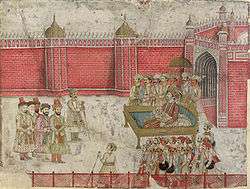Nader Shah
Nader Shah Afshar (Persian: نادر شاه افشار; also known as Nader Qoli Beyg نادر قلی بیگ or Tahmāsp Qoli Khan تهماسپ قلی خان) (August 1688[6] – 19 June 1747) was one of the most powerful Iranian rulers in the history of the nation, ruling as Shah of Iran (Persia) from 1736 to 1747 when he was assassinated during a rebellion. Because of his military genius[14] as evidenced in his numerous campaigns throughout Middle East, Caucasus, Central and South Asia, such as the battles of Herat, Mihmandust, Murche-Khort, Kirkuk, Yeghevard, Khyber Pass, Karnal and Kars, some historians have described him as the Napoleon of Persia, Sword of Persia,[15] or the Second Alexander. Nader Shah was an Iranian who belonged to the Turkmen[16] Afshar tribe of Khorasan in northeastern Iran,[17] which had supplied military power to the Safavid dynasty since the time of Shah Ismail I.[18]
| Nader Shah | |
|---|---|
| Šāhānšāh[2] (King of Kings) | |
.jpg) A contemporary court portrait of Nader Shah by Mohammad Reza Hendi (c. 1740), now held in London's V&A | |
| Shah of Persia | |
| Reign | 8 March 1736 – 20 June 1747[3] |
| Coronation | 8 March 1736[4] |
| Predecessor | Abbas III |
| Successor | Adil Shah |
| Born | 6 August 1698,[5] or 22 November 1688[6] Dargaz, Persia[7] |
| Died | 20 June 1747[8] (aged 48, or 58) Quchan, Persia |
| Burial | |
| Queen and regent | Razia Begum Safavi |
| Issue |
|
| Dynasty | House of Afshar |
| Father | Emam Qoli |
| Religion |
|
| Seal |  |
| Military career | |
| Battles/wars | Campaigns of Nader Shah |
Nader rose to power during a period of chaos in Iran after a rebellion by the Hotaki Pashtuns had overthrown the weak Shah Sultan Husayn, while the arch-enemy of the Safavids, the Ottomans, as well as the Russians had seized Iranian territory for themselves. Nader reunited the Iranian realm and removed the invaders. He became so powerful that he decided to depose the last members of the Safavid dynasty, which had ruled Iran for over 200 years, and become Shah himself in 1736. His numerous campaigns created a great empire that, at its greatest extent, briefly encompassed what is now part of or includes Iran, Armenia, Azerbaijan, Georgia, the North Caucasus, Iraq, Turkey, Turkmenistan, Afghanistan, Uzbekistan, Bahrain, Pakistan, Oman and the Persian Gulf, but his military spending had a ruinous effect on the Iranian economy.[19]
Nader idolized Genghis Khan and Timur, the previous conquerors from Central Asia. He imitated their military prowess and—especially later in his reign—their cruelty. His victories during his campaigns briefly made him West Asia's most powerful sovereign, ruling over what was arguably the most powerful empire in the world,[20] but his empire and the Afsharid dynasty he founded quickly disintegrated after he was assassinated in 1747.[21] The turning point in his military career started from his second and third campaigns against the by then revolting Lezgians, as well as other ethnic groups of Dagestan in the northwestern parts of his domain. Nader Shah has been described as "the last great Asiatic military conqueror".[22]
Early life
Nader Shah was born in the fortress of Dastgerd[7] into the Qereqlu clan of the Afshars, a semi-nomadic Turkic Qizilbash pastoralist tribe settled in the northern valleys of Khorasan, a province in the northeast of the Iranian Empire.[23] His father, Emam Qoli, was a herdsman who may also have been a coatmaker.[24] His family lived nomadic way of life. Nader was a long-waited son in his family.[25]
At the age of 13, his father died and Nader had to find a way to support himself and his mother. He had no source of income other than the sticks he gathered for firewood, which he transported to the market. Many years later, when he was returning in triumph from his conquest of Delhi, he led the army to his birthplace and made a speech to his generals about his early life of deprivation. He said, "You now see to what height it has pleased the Almighty to exalt me; from hence, learn not to despise men of low estate." Nader's early experiences did not, however, make him particularly compassionate toward the poor. Throughout his career, he was only interested in his own advancement. Legend has it that in 1704, when he was about 17, a band of marauding Uzbek Tartars invaded the province of Khorasan, where Nader lived with his mother. They killed many peasants. Nader and his mother were among those who were carried off into slavery. His mother died in captivity. According to another story, Nader managed to convince Turkmens promising help in future, Nader returned to the province of Khorasan in 1708[25].
Fall of the Safavid dynasty
Nader grew up during the final years of the Safavid dynasty which had ruled Iran since 1502. At its peak, under such figures as Abbas the Great, Safavid Iran had been a powerful empire, but by the early 18th century the state was in serious decline and the reigning shah, Sultan Husayn, was a weak ruler. When Sultan Husayn attempted to quell a rebellion by the Ghilzai Afghans in Kandahar, the governor he sent (Gurgin Khan) was killed. Under their leader Mahmud Hotaki, the rebellious Afghans moved westwards against the shah himself and in 1722 they defeated a force at the Battle of Gulnabad and then besieged the capital, Isfahan.[26] After the Shah failed to escape or to rally a relief force elsewhere, the city was starved into submission and Sultan Husayn abdicated, handing power to Mahmud. In Khorasan, Nader at first submitted to the local Afghan governor of Mashhad, Malek Mahmud, but then rebelled and built up his own small army. Sultan Husayn's son had declared himself Shah Tahmasp II, but found little support and fled to the Qajar tribe, who offered to back him. Meanwhile, Iran's imperial neighboring rivals, the Ottomans and the Russians, took advantage of the chaos in the country to seize and divide territory for themselves.[27] In 1722, Russia, led by Peter the Great and further aided by some of the most notable Caucasian regents of the disintegrating Safavid Empire, such as Vakhtang VI, launched the Russo-Iranian War (1722-1723) in which Russia captured swaths of Iran's territories in the North Caucasus, South Caucasus, as well as in northern mainland Iran. This included mainly, but was not limited to, the losses of Dagestan (including its principal city of Derbent), Baku, Gilan, Mazandaran, and Astrabad. The regions to the west of that, mainly Iranian territories in Georgia, Iranian Azerbaijan, and Armenia, were taken by the Ottomans. The newly gained Russian and Turkish possessions were confirmed and further divided amongst themselves in the Treaty of Constantinople (1724).[28]
Fall of the Hotaki dynasty
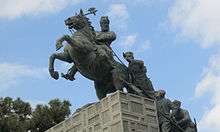
Tahmasp and the Qajar leader Fath Ali Khan (the ancestor of Agha Mohammad Khan Qajar) contacted Nader and asked him to join their cause and drive the Ghilzai Afghans out of Khorasan. He agreed and thus became a figure of national importance. When Nader discovered that Fath Ali Khan was in treacherous correspondence with Malek Mahmud and revealed this to the shah, Tahmasp executed him and made Nader the chief of his army instead. Nader subsequently took on the title Tahmasp Qoli (Servant of Tahmasp). In late 1726, Nader recaptured Mashhad.[29]
Nader chose not to march directly on Isfahan. First, in May 1729, he defeated the Abdali Afghans near Herat. Many of the Abdali Afghans subsequently joined his army. The new shah of the Ghilzai Afghans, Ashraf, decided to move against Nader but in September 1729, Nader defeated him at the Battle of Damghan and again decisively in November at Murchakhort. Ashraf fled and Nader finally entered Isfahan, handing it over to Tahmasp in December. The citizens' rejoicing was cut short when Nader plundered them to pay his army. Tahmasp made Nader governor over many eastern provinces, including his native Khorasan, and married him to his sister. Nader pursued and defeated Ashraf, who was murdered by his own followers.[30] In 1738 Nader Shah besieged and destroyed the last Hotaki seat of power at Kandahar. He built a new city near Kandahar, which he named "Naderabad".[31]
First Ottoman campaign and the regain of the Caucasus
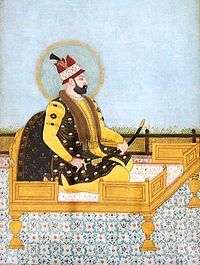
In the spring of 1730, Nader attacked Iran's archrival the Ottomans and regained most of the territory lost during the recent chaos. At the same time, the Abdali Afghans rebelled and besieged Mashhad, forcing Nader to suspend his campaign and save his brother, Ebrahim. It took Nader fourteen months to crush this uprising.
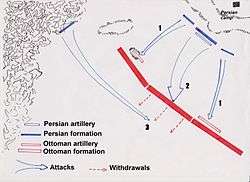
Relations between Nader and the Shah had declined as the latter grew jealous of his general's military successes. While Nader was absent in the east, Tahmasp tried to assert himself by launching a foolhardy campaign to recapture Yerevan. He ended up losing all of Nader's recent gains to the Ottomans, and signed a treaty ceding Georgia and Armenia in exchange for Tabriz. Nader, furious, saw that the moment had come to ease Tahmasp from power. He denounced the treaty, seeking popular support for a war against the Ottomans. In Isfahan, Nader got Tahmasp drunk then showed him to the courtiers asking if a man in such a state was fit to rule. In 1732 he forced Tahmasp to abdicate in favour of the Shah's baby son, Abbas III, to whom Nader became regent.
Nader decided, as he continued the 1730-35 war, that he could win back the territory in Armenia and Georgia by seizing Ottoman Baghdad and then offering it in exchange for the lost provinces, but his plan went badly amiss when his army was routed by the Ottoman general Topal Osman Pasha near the city in 1733. This was the only time that he was ever defeated in battle. Nader decided he needed to regain the initiative as soon as possible to save his position because revolts were already breaking out in Iran. He faced Topal again with a larger force and defeated and killed him. He then besieged Baghdad, as well as Ganja in the northern provinces, earning a Russian alliance against the Ottomans. Nader scored a great victory over a superior Ottoman force at Baghavard and by the summer of 1735, Iranian Armenia and Georgia were his again. In March 1735, he signed a treaty with the Russians in Ganja by which the latter agreed to withdraw all of their troops from Iranian territory,[32][33] those which had not been ceded back by the 1732 Treaty of Resht yet, resulting in the reestablishment of Iranian rule over all of the Caucasus and northern mainland Iran again.
Nader becomes Shah of Iran
Nader suggested to his closest intimates, after a great hunting party on the Moghan plains (presently split between Azerbaijan and Iran), that he should be proclaimed the new king (shah) in place of the young Abbas III.[34] The small group of close intimates, Nader's friends, included Tahmasp Khan Jalayer and Hasan-Ali Beg Bestami.[34] Following Nader's suggestion, the group did not "demur", and Hasan-Ali remained silent.[34] When Nader asked him why he remained silent, Hasan-Ali replied that the best thing for Nader to do would be assembling all leading men of the state, in order to receive their agreement in "a signed and sealed document of consent".[34] Nader approved with the proposal, and the writers of the chancellery, which included the court historian Mirza Mehdi Khan Astarabadi, were instructed with sending out orders to the military, clergy and nobility of the nation to summon at the plains.[34] The summonses for the people to attend had gone out in November 1735, and they began arriving in January 1736.[35] In the same month of January 1736, Nader held a qoroltai (a grand meeting in the tradition of Genghis Khan and Timur) on the Moghan plains. The Moghan plain was specifically chosen for its size and "abundance of fodder".[36] Everyone agreed to the proposal of Nader becoming the new king, many—if not most—enthusiastically, the rest fearing Nader's anger if they showed support for the deposed Safavids. Nader was crowned Shah of Iran on March 8, 1736, a date his astrologers had chosen as being especially propitious,[37] in attendance of an "exceptionally large assembly" composed of the military, religious and nobility of the nation, as well as the Ottoman ambassador Ali Pasha.[38]
Religious policy
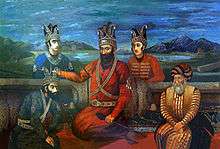
The Safavids had introduced Shi'a Islam as the state religion of Iran. Nader was probably brought up as a Shi'a [39] but later espoused the Sunni[40] faith as he gained power and began to push into the Ottoman Empire. He believed that Safavid Shi'ism had intensified the conflict with the Sunni Ottoman Empire. His army was a mix of Shi'a and Sunni (with a notable minority of Christians) and included his own Qizilbash as well as Uzbeks, Afghans, Christian Georgians and Armenians,[41][42] and others. He wanted Iran to adopt a form of religion that would be more acceptable to Sunnis and suggested that Iran adopt a form of Shi'ism he called "Ja'fari", in honour of the sixth Shi'a imam Ja'far al-Sadiq. He banned certain Shi'a practices which were particularly offensive to Sunnis, such as the cursing of the first three caliphs. Personally, Nader is said to have been indifferent towards religion and the French Jesuit who served as his personal physician reported that it was difficult to know which religion he followed and that many who knew him best said that he had none.[43] Nader hoped that "Ja'farism" would be accepted as a fifth school (mazhab) of Sunni Islam and that the Ottomans would allow its adherents to go on the hajj, or pilgrimage, to Mecca, which was within their territory. In the subsequent peace negotiations, the Ottomans refused to acknowledge Ja'farism as a fifth mazhab but they did allow Iranian pilgrims to go on the hajj. Nader was interested in gaining rights for Iranians to go on the hajj in part because of revenues from the pilgrimage trade.[19] Nader's other primary aim in his religious reforms was to weaken the Safavids further since Shi'a Islam had always been a major element in support for the dynasty. He had the chief mullah of Iran strangled after he was heard expressing support for the Safavids. Among his reforms was the introduction of what came to be known as the kolah-e Naderi. This was a hat with four peaks which symbolised the first four caliphs.[19][37]
In 1741, eight Muslim mullahs and three European and five Armenian priests translated the Koran and the Gospels. The commission was supervised by Mīrzā Moḥammad Mahdī Khan Monšī, the court historiographer and author of the Tarikh-e-Jahangoshay-e-Naderi (History of Nadir Shah's Wars). Finished translations were presented to Nāder Shah in Qazvīn in June, 1741, who, however, was not impressed.
Invasion of India
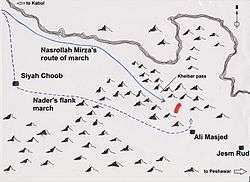
In 1738, Nader Shah conquered Kandahar, the last outpost of the Hotaki dynasty. His thoughts now turned to the Mughal Empire of India. This once powerful Muslim state to the east was falling apart as the nobles became increasingly disobedient and local opponents such as the Sikhs and Hindu Marathas of the Maratha Empire were expanding upon its territory. Its ruler Muhammad Shah was powerless to reverse this disintegration. Nader asked for the Afghan rebels to be handed over, but the Mughal emperor refused. Nader used the pretext of his Afghan enemies taking refuge in India to cross the border and invade the militarily weak but still extremely wealthy far eastern empire,[44] and in a brilliant campaign against the governor of Peshawar he took a small contingent of his forces on a daunting flank march through nearly impassable mountain passes and took the enemy forces positioned at the mouth of the Khyber Pass completely by surprise, utterly beating them despite being outnumbered two-to-one. This led to the capture of Ghazni, Kabul, Peshawar, Sindh and Lahore. As he moved into the Mughal territories, he was loyally accompanied by his Georgian subject and future king of eastern Georgia, Erekle II, who led a Georgian contingent as a military commander as part of Nader's force.[45] Following the prior defeat of Mughal forces, he then advanced deeper into India, crossing the river Indus before the end of year. The news of the Iranian army's swift and decisive successes against the northern vassal states of the Mughal empire caused much consternation in Delhi, prompting the Mughal ruler, Muhammad Shah, to raise an army of some 300,000 men and march to confront Nader Shah.
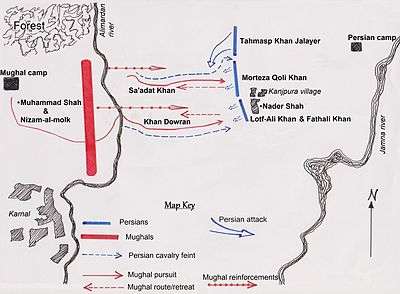
Despite being outnumbered by six to one, Nader Shah crushed the Mughal army in less than three hours at the huge Battle of Karnal on 13 February 1739. After this spectacular victory, Nader captured Mohammad Shah and entered Delhi.[46] When a rumour broke out that Nader had been assassinated, some of the Indians attacked and killed Iranian troops; by midday 900 Iranian soldiers had been killed.[47] Nader, furious, reacted by ordering his soldiers to sack the city. During the course of one day (March 22) 20,000 to 30,000 Indians were killed by the Iranian troops and as many as 10,000 women and children were taken as slaves, forcing Mohammad Shah to beg Nader for mercy.[48][47]
In response, Nader Shah agreed to withdraw, but Mohammad Shah paid the consequence in handing over the keys of his royal treasury, and losing even the fabled Peacock Throne to the Iranian emperor. The Peacock Throne, thereafter, served as a symbol of Iranian imperial might. It is estimated that Nader took away with him treasures worth as much as seven hundred million rupees. Among a trove of other fabulous jewels, Nader also looted the Koh-i-Noor (meaning "Mountain of Light" in Persian) and Darya-ye Noor (meaning "Sea of Light") diamonds. The Iranian troops left Delhi at the beginning of May 1739, but before they left, he ceded back to Muhammad Shah all territories to the east of the Indus which he had overrun.[49] The booty they had collected was loaded on 700 elephants, 4,000 camels, and 12,000 horses.[47] The plunder seized from India was so much that Nader stopped taxation in Iran for a period of three years following his return.[50] Many historians believe that Nader attacked the Mughal Empire to, perhaps, give his country some breathing space after previous turmoils. His successful campaign and replenishment of funds meant that he could continue his wars against Iran's archrival and neighbour, the Ottoman Empire,[51] as well as the campaigns in the North Caucasus. Nader also secured one of the Mughal emperor's daughters, Jahan Afruz Banu Begum, as a bride for his youngest son.
North Caucasus, Central Asia, Arabia, and the second Ottoman war
.jpg)
The Indian campaign was the zenith of Nader's career. Afterwards he became increasingly despotic as his health declined markedly. Nader had left his son Reza Qoli Mirza to rule Iran in his absence. Reza had behaved highhandedly and somewhat cruelly but he had kept the peace in Iran. Having heard rumours that his father had died, he had made preparations for assuming the crown. These included the murder of the former shah Tahmasp and his family, including the nine-year-old Abbas III. On hearing the news, Reza's wife, who was Tahmasp's sister, committed suicide. Nader was not impressed with his son's waywardness and reprimanded him, but he took him on his expedition to conquer territory in Transoxiana. In 1740 he conquered Khanate of Khiva. After the Iranians had forced the Uzbek khanate of Bukhara to submit, Nader wanted Reza to marry the khan's elder daughter because she was a descendant of his hero Genghis Khan, but Reza flatly refused and Nader married the girl himself.[52]
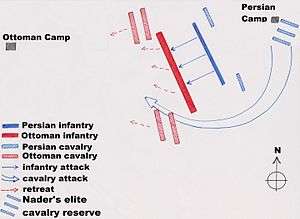
Nader now decided to punish Daghestan for the death of his brother Ebrahim Qoli on a campaign a few years earlier. In 1741, while Nader was passing through the forest of Mazanderan on his way to fight the Daghestanis, an assassin took a shot at him but Nader was only lightly wounded. He began to suspect his son was behind the attempt and confined him to Tehran. Nader's increasing ill health made his temper ever worse. Perhaps it was his illness that made Nader lose the initiative in his war against the Lezgin tribes of Daghestan. Frustratingly for him, they resorted to guerrilla warfare and the Iranians could make little headway against them.[53] Though Nader managed to take most of Dagestan during his campaign, the effective guerrilla warfare as deployed by the Lezgins, but also the Avars and Laks made the Iranian re-conquest of the particular North Caucasian region a short lived one; several years later, Nader was forced to withdraw. During the same period, Nader accused his son of being behind the assassination attempt in Mazanderan. Reza Qoli angrily protested his innocence, but Nader had him blinded as punishment, and ordered his eyes to be brought to him on a platter. When his orders had been carried out, however, Nader instantly regretted it, crying out to his courtiers, "What is a father? What is a son?"[51] Soon afterwards, Nader started executing the nobles who had witnessed his son's blinding. In his last years, Nader became increasingly paranoid, ordering the assassination of large numbers of suspected enemies.
With the wealth he gained, Nader started to build an Iranian navy. With lumber from Mazandaran, he built ships in Bushehr. He also purchased thirty ships in India.[19] He recaptured the island of Bahrain from the Arabs. In 1743, he conquered Oman and its main capital Muscat. In 1743, Nader started another war against the Ottoman Empire. Despite having a huge army at his disposal, in this campaign Nader showed little of his former military brilliance. It ended in 1746 with the signing of a peace treaty, the Treaty of Kerden, in which the Ottomans agreed to let Nader occupy Najaf.[54]
Domestic policies
Nader changed the Iranian coinage system. He minted silver coins, called Naderi, that were equal to the Mughal rupee.[19] Nader discontinued the policy of paying soldiers based on land tenure.[19] Like the late Safavids he resettled tribes. Nader Shah transformed the Shahsevan, a nomadic group living around Azerbaijan whose name literally means "shah lover", into a tribal confederacy which defended Iran against the neighbouring Ottomans and Russians.[55][56] In addition, he increased the number of soldiers under his command and reduced the number of soldiers under tribal and provincial control.[19] His reforms may have strengthened the country, but they did little to improve Iran's suffering economy.[19]
Death and legacy
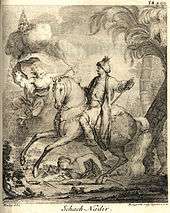
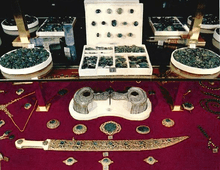
Nader became increasingly cruel as a result of his illness and his desire to extort more and more tax money to pay for his military campaigns. New revolts broke out and Nader crushed them ruthlessly, building towers from his victims' skulls in imitation of his hero Timur. In 1747, Nader set off for Khorasan, where he intended to punish Kurdish rebels. Some of his officers and courtiers feared he was about to execute them and plotted against him, including two of his relatives: Muhammad Quli Khan, the captain of the guards, and Salah Khan, the overseer of Nader's household. Nader Shah was assassinated on 20 June 1747,[8] at Quchan in Khorasan. He was surprised in his sleep by around fifteen conspirators, and stabbed to death. Nader was able to kill two of the assassins before he died.[58]
The most detailed account of Nader's assassination comes from Père Louis Bazin, Nader's physician at the time of his death, who relied on the eyewitness testimony of Chuki, one of Nader's favourite concubines:
Around fifteen of the conspirators were impatient or merely eager to distinguish themselves, and so turned up prematurely at the agreed meeting place. They entered the enclosure of the royal tent, pushing and smashing their way through any obstacles, and penetrated into the sleeping quarters of that ill-starred monarch. The noise they made on entering woke him up: ‘Who goes there?’ he shouted out in a roar. ‘Where is my sword? Bring me my weapons!’ The assassins were struck with fear by these words and wanted to escape, but ran straight into the two chiefs of the murder-conspiracy, who allayed their fears and made them go into the tent again. Nader Shah had not yet had time to get dressed; Muhammad Quli Khan ran in first and struck him with a great blow of his sword which felled him to the ground; two or three others followed suit; the wretched monarch, covered in his own blood, attempted – but was too weak – to get up, and cried out, ‘Why do you want to kill me? Spare my life and all I have shall be yours!’ He was still pleading when Salah Khan ran up, sword in hand and severed his head, which he dropped into the hands of a waiting soldier. Thus perished the wealthiest monarch on earth.[14][47]
After his death, he was succeeded by his nephew Ali Qoli, who renamed himself Adil Shah ("righteous king"). Adil Shah was probably involved in the assassination plot.[32] Adil Shah was deposed within a year. During the struggle between Adil Shah, his brother Ibrahim Khan and Nader's grandson Shah Rukh and almost all provincial governors declared independence, established their own states, and the entire Empire of Nader Shah fell into anarchy. Oman and the Uzbek khanates of Bukhara and Khiva regained independence, while the Ottoman Empire regained the lost territories in Western Armenia and Mesopotamia. Finally, Karim Khan founded the Zand dynasty and became ruler of Iran by 1760. Erekle II and Teimuraz II, who, in 1744, had been made the kings of Kakheti and Kartli respectively by Nader himself for their loyal service,[59] capitalized on the eruption of instability, and declared de facto independence. Erekle II assumed control over Kartli after Teimuraz II's death, thus unifying the two as the Kingdom of Kartli-Kakheti, becoming the first Georgian ruler in three centuries to preside over a politically unified eastern Georgia,[60] and due to the frantic turn of events in mainland Iran he would be able to maintain its autonomy until the advent of the Iranian Qajar dynasty.[61] The rest of the Iranian territories in the Caucasus, comprising modern-day Azerbaijan, Armenia, and Dagestan broke away into various khanates. Until the advent of the Zands and Qajars, its rulers had various forms of autonomy, but stayed vassals and subjects to the Iranian king.[62] In the far east, Ahmad Shah Durrani had already proclaimed independence, marking the foundation of modern Afghanistan. Iran finally lost Bahrain to House of Khalifa during Invasion of Bani Utbah in 1783.
Nader Shah was well known to the European public of the time. In 1768, Christian VII of Denmark commissioned Sir William Jones to translate a Persian language biography of Nader Shah written by his Minister Mirza Mehdi Khan Astarabadi into French.[63] It was published in 1770 as Histoire de Nadir Chah.[64] Nader's Indian campaign alerted the British East India Company to the extreme weakness of the Mughal Empire and the possibility of expanding to fill the power vacuum. Without Nader, "eventual British [in India] would have come later and in a different form, perhaps never at all - with important global effects".[65]
Personality
The strong character of Nader Shah is indicated by the fact that having achieved much fame and glory, he did not allow his pleasers to find great ancestors in the darkness of his origin. He never boasted of a proud genealogy; on the contrary, he often spoke of his simple origin. Even his chronicler was forced to limit himself by saying that diamond was valued not by the rock where it had been found, but by its splendor. There is a story that says, having demanded the daughter of his defeated enemy Muhammad Shah, the Emperor of Delhi, to marry his son Nasrullah, he received the answer that a royal lineage up to the 7th generation was required for marriage with a princess from the House of Timur.
“Tell him,” Nader replied, “that Nasrullah is the son of Nader Shah, the son and grandson of the sword, and so on, not until the 7th, but until the 70th generation.”
Nader had the greatest contempt for the weak, depraved Mahmud Shah, who, according to the local chronicler of that era, “was always with his mistress in his arms and a glass in his hand,” and was the lowest libertine and simply a puppet ruler.[66] Nader Shah once had a conversation with a holy man about paradise. After what that man described miracles and pleasures of the heaven, the shah asked:
“Are there such things as war and victory over the enemy in paradise?” When the man answered negatively, Nader replied: “How can there be any pleasure then?”.[67]
French orientalist Louis Bazin describes the personality of Nader Shah as follows:
“Despite his obscure background, he looked born for the throne. Nature endowed him with all the great qualities that make heroes ... His dyed beard made a sharp contrast with his completely gray hair; his natural physique was strong, tall, and his waist was proportional to his growth; his expression was gloomy, with an oblong face, an aquiline nose and a beautiful mouth, but with his lower lip protruding forward. He had small penetrating eyes with a sharp and piercing gaze; his voice was rude and loud, although he knew how to soften it on occasion, as required by personal interest...
He did not have a permanent home - his military camp was his court; his palace was his tent, and his closest confidants were his bravest soldiers ... Undaunted in battle, he brought courage, and was always in the thick of danger among his brave men, as long as the battle lasted ... He did not neglect any of the measures dictated by foresight ... Nevertheless, the repulsive greed and unprecedented cruelties that wore his subjects, ultimately led to his fall, and the extremes and horrors that were caused by him, made Persia cry. He was adored, feared and cursed at the same time ”.[68]
English traveler Jonas Hanway, who lived in the courtyard of Nader Shah, describes him:
“Nader Shah is taller than 6 feet, well-built, very physically strong. He has such an unusually loud voice that he can give orders to his people at a distance of about 100 yards. He drinks wine moderately, hours of his rest among ladies are very rare, his food is simple, and if government affairs require his presence, he rejects his meal and satisfies hunger with fried peas (which he always carries in his pocket) and a sip of water... He is extremely generous, especially to his warriors, and generously rewards all who have distinguished themselves in his service. At the same time, he is very severe and strict in relation to discipline, punishing with the death penalty all who have committed major misconduct... He never forgives the guilty, no matter what rank he is. Being on a march or in the field, he confines himself to food, drink and sleep of a simple soldier and forces all his officers to follow the same harsh discipline. He has such a strong physique that he often sleeps on a frosty night on bare ground in the open air, wrapping himself only in his cloak and putting a saddle under his head as a pillow. In private conversations, no one is allowed to talk about government affairs.[69]
Member of the French Academy of Sciences, Pierre Bayen wrote about Nader Shah the following:
“He was the horror of the Ottoman Empire, the conqueror of India, the ruler of Persia and all of Asia. His neighbors respected him, his enemies were afraid of him, and he lacked only the love of his subjects ”.[70]
One Punjabi contemporary poet described the rule of Nader as a time “when all of India trembled with horror”.[71] The Kashmirian historian Lateef described him as follows: “Nader Shah, the horror of Asia, the pride and savior of his country, the restorer of her freedom and conqueror of India, who, having a simple origin, rose to such greatness that monarchs rarely have from birth”.[72] Joseph Stalin used to read about Nader Shah and admired him, calling him, along with Ivan the Terrible, a teacher. In Europe, Nader Shah was compared to Alexander the Great. Starting from a young age, Napoleon Bonaparte also used to read about and admire Nader Shah. Napoleon considered himself new Nader, and he himself was later called European Nader Shah.[73]
See also
- Nader's Central Asian Campaign
- Nader's Campaigns
- History of the Caucasus
- Afsharid navy
- Ideology of Safavids
- Lezgins
- Safavid conversion of Iran from Sunnism to Shiism
- Treaty of Kerden
- Treaty of Resht
- Jahangusha-i Naderi, the most important book on the reign and wars of Nader Shah
References
- Ernest Tucker (15 August 2006), "NĀDER SHAH", Encyclopædia Iranica (Online ed.), ISSN 2330-4804
- Ernest Tucker (15 August 2006), "NĀDER SHAH", Encyclopædia Iranica (Online ed.), ISSN 2330-4804
- Michael Axworthy's biography of Nader, The Sword of Persia (I.B. Tauris, 2006), pp. 165, 279
- Michael Axworthy's biography of Nader, The Sword of Persia (I.B. Tauris, 2006), pp. 165
- Michael Axworthy's biography of Nader, The Sword of Persia (I.B. Tauris, 2006), p. 17
- Nader's exact date of birth is unknown but August 6 is the "likeliest" according to Axworthy, p. 17 (and note) and The Cambridge History of Iran (vol. 7, p. 3); other biographers favour 1688.
- "The Cambridge History of Iran Volume 7". cambridge.org. Archived from the original on 2012-07-31.
- "AFSHARIDS". iranicaonline.org.
- Michael Axworthy's biography of Nader, The Sword of Persia (I.B. Tauris, 2006), p. 34
- Tucker, Ernest, "Nadir Shah and the Ja'fari Mazhab reconsidered", in Iranian Studies, vol. 27, 1-4 (1994), 163–179.
- Tucker, Ernest. Nadir Shah's quest for legitimacy in post-Safavid Iran. University Press Florida, 2006
- Lockhart, Laurence. Nadir Shah: A critical study based mainly upon contemporary sources. London, Luzac & Co, 1938, p.278
- Michael Axworthy's biography of Nader, The Sword of Persia (I.B. Tauris, 2006), pp. 168–170
- The Sword of Persia: Nader Shah, from Tribal Warrior to Conquering Tyrant "Nader commanded the most powerful military force in Asia, if not the world"
- Axworthy, p. xvii
- Lockhart, L., "Nadir Shah: A Critical Study Based Mainly upon Contemporary Sources", London: Luzac & Co., 1938, 21 :"Nadir Shah was from a Turkmen tribe and probably raised as a Shiʿa, though his views on religion were complex and often pragmatic"
- Michael Axworthy's biography of Nader, The Sword of Persia (I.B. Tauris, 2006), pp. 17–19: "His father was of lowly but respectable status, a herdsman of the Afshar tribe ... The Qereqlu Afshars to whom Nader's father belonged were a semi-nomadic Turcoman tribe settled in Khorasan in north-eastern Iran ... The tribes of Khorasan were for the most part ethnically distinct from the Persian-speaking population, speaking Turkic or Kurdish languages. Nader's mother tongue was a dialect of the language group spoken by the Turkic tribes of Iran and Central Asia, and he would have quickly learned Persian, the language of high culture and the cities as he grew older. But the Turkic language was always his preferred everyday speech, unless he was dealing with someone who knew only Persian."
- Stephen Erdely and Valentin A. Riasanovski. The Uralic and Altaic Series, Routledge, 1997, ISBN 0-7007-0380-2, p. 102
- Ernest Tucker (March 29, 2006). "Nāder Shāh 1736-47". Encyclopædia Iranica.
- Modern Conflict in the Greater Middle East: A Country-by-Country Guide page : 84 "Under its great ruler and military leader Nader Shah (1736-1747), Persia was arguably the world's most powerful empire"
- Axworthy, Michael (24 March 2010). The Sword of Persia: Nader Shah, from Tribal Warrior to Conquering Tyrant. ISBN 9780857721938. Retrieved 27 May 2014.
- Cambridge History of Iran Vol.7, p. 59
- Axworthy, pp. 17–18
- Axworthy, p. 17,
- Axworthy 2006.
- "An Outline of the History of Persia During the Last Two Centuries (A.D. 1722-1922)". Edward G. Browne. London: Packard Humanities Institute. p. 30. Retrieved 2010-09-24.
- This section: Axworthy, pp. 17–56.
- Houtsma, M. Th.; van Donzel, E. (1993). E. J. Brill's First Encyclopaedia of Islam, 1913-1936. BRILL. p. 760. ISBN 90-04-08265-4.
- Axworthy, pp. 57–74.
- Axworthy, pp. 75–116.
- Encyclopedia Iranica
- Elton L. Daniel, "The History of Iran" (Greenwood Press 2000) p. 94
- Lawrence Lockhart Nadir Shah (London, 1938)
- Fisher et al. 1991, pp. 34.
- Fisher et al. 1991, pp. 36.
- Fisher et al. 1991, pp. 35.
- This section: Axworthy, pp. 137-174.
- Fisher et al. 1991, pp. 34-36.
- Axworthy, p. 34.
- The Afghan Interlude and the Zand and Afshar Dynasties, Kamran Scot Aghaie, The Oxford Handbook of Iranian History, ed. Touraj Daryaee, (Oxford University Press, 2012), 316.
- "The Army of Nader Shah" (PDF). Archived from the original (PDF) on 3 March 2016. Retrieved 17 December 2014.
- Steven R. Ward. Immortal, Updated Edition: A Military History of Iran and Its Armed Forces Georgetown University Press, 8 jan. 2014 p 52
- Axworthy, p. 168.
- Raghunath Rai. "History". p. 19 FK Publications ISBN 8187139692
- David Marshall Lang. Russia and the Armenians of Transcaucasia, 1797-1889: a documentary record Columbia University Press, 1957 (digitalised March 2009, originally from the University of Michigan) p 142
- "An Outline of the History of Persia During the Last Two Centuries (A.D. 1722-1922)". Edward G. Browne. London: Packard Humanities Institute. p. 33. Retrieved 2010-09-24.
- William Dalrymple, Anita Anand (2017). Koh-i-Noor. Bloomsbury Publishing. pp. 52–60.
- Axworthy, p. 8.
- Axworthy, Michael (2010). Sword of Persia: Nader Shah, from Tribal Warrior to Conquering Tyrant. I.B. Tauris. pp. 212, 216. ISBN 978-0857733474.
- This section: Axworthy, pp. 1–16, 175–210.
- Axworthy, Michael (24 March 2010). The Sword of Persia: Nader Shah, from Tribal Warrior to Conquering Tyrant. ISBN 9780857721938. Retrieved 8 March 2015.
- Svat Soucek, a history of inner asia page 195: in 1740 Nadir Shah, the new ruler of Iran, crossed the Amu Darya and, accepting the submission of Muhammad Hakim Bi which was then formalized by the acquiescence of Abulfayz Khan himself, proceeded to attack Khiva. When rebellions broke out in 1743 upon the death of Muhammad Hakim, the shah dispatched the ataliq’s son Muhammad Rahim Bi, who had accompanied him to Iran, to quell them. Mohammad hakim bi was ruler of the khanate of bukhara at that time Archived 2015-06-10 at the Wayback Machine
- Spencer C. Tucker. "A Global Chronology of Conflict: From the Ancient World to the Modern Middle East: From the Ancient World to the Modern Middle East" p 739
- This section: Axworthy, pp. 175–274.
- Floor, Willem. Journal of the American Oriental Society, Vol. 119, No. 3. (Jul. - Sep., 1999), p. 543. Book review of Richard Tapper's Frontier Nomads of Iran: A Political and Social History of the Shahsevan.
- Daniel, Elton L. The History of Iran. Greenwood Publishing Group: 2000. p. 90.
- Axworthy, p. 273.
- "History of Iran: Afsharid Dynasty (Nader Shah)". iranchamber.com.
- Ronald Grigor Suny. "The Making of the Georgian Nation" Indiana University Press, 1994. ISBN 978-0253209153 p 55
- Yar-Shater, Ehsan. Encyclopaedia Iranica, Vol. 8, parts 4-6 Routledge & Kegan Paul (original from the University of Michigan) p 541
- Fisher et al. 1991, p. 328.
- Encyclopedia of Soviet law By Ferdinand Joseph Maria Feldbrugge, Gerard Pieter van den Berg, William B. Simons, Page 457
- "SIR WILLIAM JONES (174... - Online Information article about SIR WILLIAM JONES (174..." jrank.org. Archived from the original on 2017-06-30. Retrieved 2008-01-06.
- Axworthy, p. 330.
- Axworthy, p. xvi.
- T. E. Gordon. Persia Revisited.
- L. Lockhart, «Nadir Shah : A Critical Study Based Mainly Upon Contemporary Sources»
- W. Dalrymple, A. Anand, «Koh-i-Noor: The History of the World’s Most Infamous Diamond», p. 48
- R. B. Kaul, «Ballad on Nadir Shah's Invasion in India», p. 3-4
- W. Dalrymple, A. Anand, «Koh-i-Noor: The History of the World’s Most Infamous Diamond»
- E. Tucker, «Nadir Shah’s Quest for Legitimacy in Post-Safavid Iran», p. 6
- R. B. Kaul, «Ballad on Nadir Shah's Invasion in India», p. 16
- Rudi Matthee, «Nādir Shāh in Iranian Historiography: Warlord or National Hero?»
Sources
- Michael Axworthy, The Sword of Persia: Nader Shah, from Tribal Warrior to Conquering Tyrant Hardcover 348 pages (26 July 2006) Publisher: I.B. Tauris Language: English ISBN 1-85043-706-8
- Fisher, William Bayne; Avery, P.; Hambly, G. R. G; Melville, C. (1991). The Cambridge History of Iran. 7. Cambridge: Cambridge University Press. ISBN 0521200954.CS1 maint: ref=harv (link)
Further reading
- Lawrence Lockhart Nadir Shah (London, 1938)
- Ernest Tucker, Nadir Shah's Quest for Legitimacy in Post-Safavid Iran Hardcover 150 pages (4 October 2006) Publisher: University Press of Florida Language: English ISBN 0-8130-2964-3
- Michael Axworthy, Iran: Empire of the Mind: A History from Zoroaster to the Present Day (Paperback) ISBN 0-14-103629-X Publisher Penguin 6 November 2008
External links
| Wikimedia Commons has media related to Nader Shah. |
Nader Shah Afshar Qereqlu clan Cadet branch of the Afshar tribe Born: 22 November 1688 Died: 19 June 1747 | ||
| Iranian royalty | ||
|---|---|---|
| Preceded by Abbas III |
Shah of Persia 8 March 1736 – 19 June 1747 |
Succeeded by Adel Shah Afshar |
| Regnal titles | ||
| New title | Regent of Persia 7 September 1732 - 7 March 1736 |
Vacant Title next held by Reza Qoli Mirza Afshar |
| Political offices | ||
| Preceded by Mohammad Ali Khan Qoullar-Aqasi |
Premier of Persia 1729 - 7 March 1736 |
Vacant Title next held by Mirza Ali Akbar Shirazi |
| Military offices | ||
| Unknown | Qurchi-bashi 1729 - 7 March 1736 |
Unknown |
